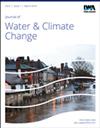农林土壤中温室气体通量和土壤理化性质的动态
IF 2.7
4区 环境科学与生态学
Q2 WATER RESOURCES
引用次数: 0
摘要
研究土壤中的温室气体(GHG)通量(CO2、CH4和N2O)对于制定有效的缓解气候变化战略至关重要。在本研究中,我们调查了农业和森林土壤中的温室气体通量,以探索土壤温室气体通量的变化,并评估温室气体与其他物理化学性质的关系。结果表明,由于施肥和异养硝化作用,森林土壤的CO2通量较高,而农业土壤的N2O通量较高。森林土壤充当CH4汇,这与孔隙度增加和体积密度降低有关。在农业土壤中,CO2和N2O与NH4+、土壤温度、pH、土壤有机碳、总氮、植物有效磷和微生物生物量氮(mbN)密切相关,但与容重和微生物生物质碳(mbC)呈负相关。与CO2和N2O相比,农业土壤中的CH4与所有物理化学性质呈反比。在森林土壤中,CO2和CH4与土壤温度和mbC呈正相关,而mbN和N2O与容重和pH呈负相关。这项研究强调,为了有效缓解气候变化,迫切需要理解土壤物理化学性质与GHG通量之间的复杂关系。本文章由计算机程序翻译,如有差异,请以英文原文为准。
Dynamics of greenhouse gas fluxes and soil physico-chemical properties in agricultural and forest soils
Examination of greenhouse gas (GHG) fluxes (CO2, CH4, and N2O) in soils is crucial for developing effective strategies to mitigate climate change. In this study, we investigated the GHG fluxes in agricultural and forest soils to explore the changes in soil GHG fluxes, and assess the relationships of GHGs with other physico-chemical properties. Results show that forest soils have a higher CO2 flux, while agricultural soils have a higher N2O flux due to fertilizer application and heterotrophic nitrification. Forest soils act as a CH4 sink, which are connected with increased porosity and decreased bulk density. In agricultural soils, CO2 and N2O were strongly linked with NH4+, soil temperature, pH, soil organic carbon, total nitrogen, plant-available phosphorous, and microbial biomass nitrogen (mbN) but were negatively connected with bulk density and microbial biomass carbon (mbC). In contrast to CO2 and N2O, CH4 in agricultural soils exhibited inverse relationships with all physico-chemical properties. In forest soils, CO2 and CH4 were positively correlated with soil temperature and mbC, and mbN and N2O were negatively correlated with bulk density and pH. This study highlights the critical need to comprehend the complex relationship between soil physico-chemical properties and GHG fluxes for effective climate change mitigation.
求助全文
通过发布文献求助,成功后即可免费获取论文全文。
去求助
来源期刊

Journal of Water and Climate Change
WATER RESOURCES-
CiteScore
4.80
自引率
10.70%
发文量
168
审稿时长
>12 weeks
期刊介绍:
Journal of Water and Climate Change publishes refereed research and practitioner papers on all aspects of water science, technology, management and innovation in response to climate change, with emphasis on reduction of energy usage.
 求助内容:
求助内容: 应助结果提醒方式:
应助结果提醒方式:


